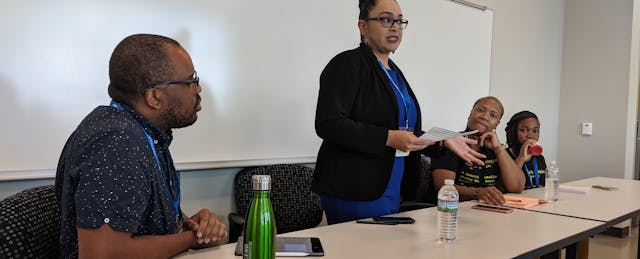HOUSTON — Systemic solutions are needed to meet students’ basic human needs, Sara Goldrick-Rab advised approximately 500 college professors and administrators assembled at the fourth annual #RealCollege conference, held last weekend at a campus of Houston Community College.
Think beyond ad hoc food pantries and consider structured food scholarships, she said. Use data to design campus programs, then measure the results to assess what’s actually working. And as the presidential election looms, make sure students are registered to vote.
Goldrick-Rab—an activist and professor at Temple University who one enthusiastic speaker said should be a future U.S. secretary of education—recently threw her endorsement behind what she hopes is one such solution: an app that quickly dispenses college emergency aid funds to students. Called Edquity, the company was a conference sponsor and is launching in October for students enrolled at its first client institution, the Dallas County Community College District.
“My big hope on this is by the conference next year, we’ll have a ton of students here that Edquity helped,” Goldrick-Rab said in an interview with EdSurge.
When it comes to eradicating poverty and overcoming racial disparities in the U.S., “education is not the magic antidote,” warned Darrick Hamilton, executive director of the Kirwan Institute for the Study of Race and Ethnicity at Ohio State University, in his keynote address. After all, he noted, black families whose heads of household earned a college degree fair worse financially than white families whose heads of household dropped out of high school.
Even if higher education alone isn’t enough to guarantee that poor students and students of color prosper, it was clear that most conference attendees still consider college necessary, especially as economic and technological changes set jobs with decent wages beyond reach for people who lack advanced credentials.
“College is imperative for everyone,” said Eduardo Padrón, president of Miami Dade College.
Here are a few takeaways from the conference:
Edquity goes live.
Many colleges have emergency aid funds to help students with basic needs like food and transportation, but the process of distributing that money to students can be slow and burdensome. To address this, several years ago Goldrick-Rab started the Fast Fund, which provides small grants to professors who give that money at their discretion to students in need.
This summer, she joined Edquity as chief strategy officer for emergency aid. The for-profit company, which has raised more than $1.5 million from Lumina Impact Ventures, Wells Fargo, CFSI, the Bill and Melinda Gates Foundation and the New Schools Venture Fund, seeks to manage emergency aid funds on behalf of colleges that pay for the service.
Students at those institutions can create free accounts through the app to request and quickly receive aid money without having to “perform their poverty” for administrators, said David Helene, Edquity founder, in an interview with EdSurge. And the app is designed to use consistent criteria to render aid allocation decisions, rather than requiring campus staff to make those tough choices.
“It is so hard to look at a student and decide, ‘Should they get help or not?’ There is so much bias,” Goldrick-Rab said in an interview. “Even the way you look could change my decision about you. I think science should drive whether or not you get the help. … It feels terrible to say no. That’s trauma for me and trauma for you.”
The app also includes a money-management system and a review service for social services—like Yelp. To generate revenue without charging students or selling their data, Helene said the company may introduce other financial services, such as a checking account.
Goldrick-Rab said she’s often skeptical of technology-based solutions because they tend to lack empathy. But she said she’s been impressed with Edquity’s “student-centered” design, developed through user testing intended to reduce the stigma associated with seeking help.
In a blog post announcing Goldrick-Rab’s role with the company, she disclosed that she will be financially compensated for the work, an arrangement that “helps ensure that I can direct Edquity’s efforts, keep them on track and focused on students, and helps me responsibly manage my time so I can also attend to my other existing commitments, including my family,” she wrote. She and Temple University worked out a conflict of interest plan for her participation.
“I joined Edquity as the chief strategy officer for emergency aid to take the ideas that I had from our research and operationalize them,” Goldrick-Rab said in an interview. “Everytime I say, ‘Why can’t we just do X for students?’ the team at Edquity says, ‘Yes we can.’ That’s the first time in my life.”
Collecting evidence is important but comes at a cost.
To address student poverty is to fight a war with many fronts. At a field trip to the Houston Food Bank, visitors learned that efforts to address hunger on campus often reveal interconnected problems, like poor access to public transportation and the extra time constraints faced by students who have children.

One Houston Community College student who was living out of a hotel with her kids raised new questions about the school’s food aid, said Bianca Matlock, director of financial aid operations for the college.
“We were offering produce and fresh items—where is she going to cook it? She doesn’t have a kitchen,” Matlock explained. “We’re offering her frozen meat—where is she going to store it? She doesn’t have a refrigerator. Those are things you wouldn’t normally think about.”
To identify these hidden needs and ensure programs are helping the most vulnerable students, conference speakers emphasized that campus leaders should use surveys and other methods to collect information about program results. Evidence makes it easier for lawmakers to change policy, said Atif Qarni, Virginia secretary of education, in one session. Plus, administrators want to see solid data before providing additional support for interventions, and philanthropies look for proof before offering grant dollars.
But there can be drawbacks to collecting lots of data, attendees and speakers also pointed out. Running surveys is expensive. Measuring precisely what each student takes from a food pantry can slow its operation. Undocumented students and others from marginalized groups may be skittish about using services that require them to share identifying information. And recording the emergency support that students receive can interfere with their financial-aid eligibility.
For creativity, look to community colleges.
Though the media spotlight usually seems reserved for drama at Ivy League and other selective schools, community colleges educate far more Americans: about a third of all undergraduates in fall 2017, according to the Community College Research Center. And community colleges are at the front lines of serving diverse students, enrolling about a third of both black and white undergraduates and 44 percent of Hispanic undergraduates in that same semester.
At these institutions, education can be a long and winding road. Conference participants described how family obligations, financial setbacks, transportation struggles, job duties and mental health concerns interfere with students’ studies, sometimes stretching two-year degree programs out half a decade or longer. Many students start classes at one institution but ultimately earn their diplomas elsewhere, sometimes losing access to their transcripts and earned credits in between because of unpaid tuition bills.
These disruptions are forcing community college professors and administrators to get creative by:
- Offering students badges along the way to earning larger credentials so that students have something to show for their efforts no matter how intermittent their enrollment.
- Welcoming the children of student-parents into classrooms to alleviate child care pressures.
- Enlisting librarians to point students toward campus, not just academic, resources.
- Making deals with ride-share companies to help students travel between campuses affordably.
- Inserting “basic needs security” statements into syllabi.
During a session on adaptive financial aid solutions, one conference attendee marveled aloud at “how much innovation is coming from community colleges” compared to selective four-year institutions like the one where she works.
“There is a reason this room is still predominantly community colleges,” Goldrick-Rab said in an interview while surveying the conference attendees gathered for a lunch break. “A lot of the nation’s community colleges are well on their way to this work already. They already think community is important. They already accept anyone who comes through the door.”


